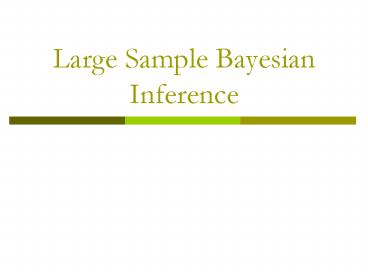Large Sample Bayesian Inference PowerPoint PPT Presentation
1 / 30
Title: Large Sample Bayesian Inference
1
Large Sample Bayesian Inference
2
Similarity between Bayesian and Frequentist
Results
- When using a non-informative prior
- Posterior Normal distribution for Normal mean
with known variance - Posterior t distribution for Normal mean with
unknown variance
3
Bayesian Asymptotics
- The properties of posterior distribution when
sample size n ? infinity - Not necessary for Bayesian inference, but useful
in approximations.
4
Normal Approximation to the Posterior
- If the posterior is unimodel symmetric, often
convenient to approximate it with a Normal
distribution.
5
Rationale Taylor Expansion of at Posterior Mode
gt
I(?) represents the curvature of the posterior at
its mode
6
Example approximate p(µ, log(s)y) in Normal
model
7
Example approximate p(µ, s2y) in Normal model
8
When n?8 Bayesian Central Limit Theorem
- Under regularity conditions
- Likelihood function is continuous
- the true parameter value ?0 is not on the
boundary - As n?8
- p(?y) converges to N(?0,nJ(?0)-1)
- where J(.) is the Fisher information
9
Outline of proof
I(?0)
10
Summary Bayesian CLT
- As n?8
11
Likelihood based methods
- Posterior mode if uniform prior
12
Counter-examples
13
Bayesian Hypothesis Testing
14
Example Cancers at Slater School
- Teachers and staff were concerned about the two
high-voltage transmission lines that ran past the
school. - observed 8 cases of cancer
- Expected 4.2 cases (according to the 145 years
of employment of teachers, staff National
Cancer Institute statistics) - --The New Yorker Dec 7, 1992.
15
Classical Hyp. Testing
- H0 Cancer rate ?4.2/1453
- YBinomial(145, ?)
- y8
- p-valuePr(Ygty?3)Pr(Y8?3) Pr(Y9?3)
Pr(Y10?3) - 0.07
- At a0.05 level, cannot reject null. Cannot
accept null either!!!
16
Consider 4 competing theories
- HA ? 3
- HB ? 4
- HC ? 5
- HD ? 6
17
Likelihood
- Pr(YyHA)Pr(Y8?0.03)0.036
- Pr(YyHB)Pr(Y8?0.04)0.096
- Pr(YyHC)Pr(Y8?0.05)0.134
- Pr(YyHD)Pr(Y8?0.06)0.136
- Theory B explains the data about 3 times
- as well as Theory A"
- Theories C and D explain the data about equally
well. - -- Bayes factorPr(yHi)/Pr(yHj)
- measures evidence.
18
Jeffreys scale of evidence for BF
- Pr(yHi)
- Bayes factor(i,j)-------------
- Pr(yHj)
- B(i,j) lt1/10 strong evidence against Hi
- 1/10 lt B(i,j) lt 1/3 moderate against Hi
- 1/3 lt B(i,j) lt 1 weak evidence against Hi
- Similar to likelihood ratio test
19
Prior Belief
- Assume HA is equally likely to be True or False.
HB HC HD are equally likely to be true - Pr(HA)1/2, Pr(HB)Pr(HC)Pr(HD)1/6
20
Posterior belief about the theories
- Pr(HAy)P(yHA)P(HA)/P(y) 0.23
- Pr(HBy)0.21
- Pr(HCy)0.28
- Pr(HDy)0.28
- The four theories seem about equally likely."
- The odds are about 3 to 1 that the underlying
cancer rate at Slater is higher than 0.03."
21
- Posterior oddsPrior odds x Bayes Factor
22
Nested Hypotheses
- H0 ?0.03
- H1 ? !0.03
- Prior belief
- Pr(H0)1/2, Pr(H1)1/2
23
Calculation of Bayes factor requires integration
- P(yH0)Bin(y3, n145, p0.03)
- P(yH1)?P(y?)p(?H1)d?
24
False Discovery Rate
25
Example
Journal of the National Cancer Insitute (6 Dec
1995).
Of 46 vegetables and fruits or related
products, four were significantly associated with
lower prostate cancer risk of the four ---
tomato sauce (P for trend 0.001), tomatoes (P
for trend 0.03), and pizza (P for trend
0.05), but not strawberries --- were primary
sources of lycopene. p-values Tomato sauce
Tomatoes Tomato juice Pizza 0.001 0.03
0.67 0.05
26
In a single test setting Type I error
- A type I error to make a discovery when there is
none.
27
When testing m hypotheses
- One may wish to control for other errors
28
False Discovery Rate V/R
- Current science is discovery driven. Not
substance driven. In other words, tomatoes didnt
lose anything. But the epidemiologist who spent
12 years on tomatoes lost the 12 years he could
have spent on strawberries.
29
False discovery rate
Bayesian Interpretation FDR Pr(H0 T(y) ?
Rejection region)
30
p-value and FDR generally have a monotonic
relationship
- The more discoveries you make, the more likely
they are false.
31
Procedures to control FDR at q
Find a p-value cutoff u such that when rejecting
all pltu, ? FDRltq
32
Benjamini-Hochberg procedure
Order p-values so that p(1)ltp(2)lt ... Let r be
the largest i such that
Reject all pltp(r)
i/m quantile
p-value
33
Thresholding is driven by the full distribution
of test statistic.

